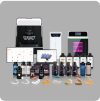
Advantages of 3D Printing in High-Volume Contract Manufacturing
Contract manufacturing services bring new low or high-volume products to market quickly without requiring large capital equipment expenditures. They lower the barriers for high-volume production as companies do not need to set up factories to manufacture products. Innovations in 3D printing have made it possible to support high-volume production at localized cloud-connected 3D printing smart factories. Utilizing a 3D printing solution for high-volume contract manufacturing helps companies stay agile, produce more complex designs, support multiple SKUs, and manufacture products with advanced high-performance materials.

How 3D Printing Supports High-Volume Contract Manufacturing
Preparing a new product for high-volume contract manufacturing requires significant preparation. Once a prototype has been completed, a manufacturer needs to create tooling and adapt the prototype’s design for production processes. Using 3D printing production solutions—either in-house or with a contract manufacturer—changes the manufacturing model and gives companies several advantages as they prepare for production:
Easily Produce Unique Designs
3D printing production systems do not place the same constraints on product design as injection molding or CNC milling, enabling unique aesthetic and functional design choices. Parts can be consolidated into simpler designs, reducing assembly time, post-production, and costs.
Use Advanced High-Performance Materials
The library of advanced 3D-printable materials has grown significantly and quickly over the past several years. New materials enable a greater range of supported designs and products. Industries benefiting from advanced 3D printing materials include:
- Footwear
- Dental products
- Medical devices
- Consumer Electronics
- Defense, automotive, and aerospace
Today’s 3D printing materials can meet or exceed the mechanical requirements for many traditional products. Designs that utilize advanced materials, such as high-performance polymers and resins, support the amalgamation of parts leading to fewer assembly steps. Many 3D printed products are indistinguishable or even superior to products made from traditional manufacturing processes.
Change Your Product Without Retooling
It is easier to modify production designs with 3D printing systems, as the manufacturing process does not require retooling. Companies can incorporate customer feedback, new features, aesthetic revisions, or other changes into qualified designs on-demand. By eliminating retooling to produce functional prototypes, validate design performance and print yield, or place new product designs into production, products can get to market faster. With better agility, companies can lower inventory holding risks associated with high-volume production and improve their ability to respond to market changes and supply disruptions—becoming more competitive.
Produce Multiple SKUs of Similar Products
3D printing production systems allow multiple SKUs of a similar product with a single process, so similar products print in parallel or series, as each SKU does not require unique tooling. Traditional manufacturing requires several production lines or changes in tooling to support multiple SKUs in production. With greater flexibility in 3D printing, companies can adopt a high-mix, low-volume manufacturing strategy to introduce several products to market simultaneously.
3D Printing Production in a Local Cloud-Connected Smart Factory
When 3D printers in a smart factory are accessible through the cloud, companies quickly get designs into production on-demand. Contract manufacturers that use 3D printing production systems can give their customers on-demand production access with low or no MOQs. Production can be distributed over several small, localized factories rather than outsourced in mass to low-cost labor regions.
High-volume contract manufacturers have more opportunities to expand their customer base and global presence with a flexible production solution. With 3D printing production systems, traditional high-volume contract manufacturers can efficiently increase their offering to include rapid prototyping as an onboarding tool for potential high-volume production customers.
Engaging earlier with potential customers utilizing 3D printing gives contract manufacturers cost and speed advantages over contract manufacturers using only traditional manufacturing methods. For those looking to work with a contract manufacturer, or contract manufacturers wanting to rise above the competition, 3D printing production systems provide a flexible solution that helps derisk manufacturing, reduces lead times, and enables greater agility. Working with the right 3D printing partner can set contract manufacturers and their customers up for success.
LuxCreo offers on-demand 3D printing production systems and services through its cloud-connected smart factory. Whether you need a single prototype or to scale to high-volume quickly, LuxCreo offers a flexible on-demand production option and an easy way to scale production of new or existing products. To learn more about leveraging the advantages of 3D printing production solutions for high-volume contract manufacturing, visit our contact page or call (650) 336-0888.
Subscribe to Our Newsletter
Be the first to get our latest updates and free trials!
Popular Resources
Follow Us
Featured Products

4D Aligner™
First Smart ActiveMemory™
Aligner

iLux Pro Dental Solution
Ultimate 1-Click Dental
Application Solution

LuxCloud Dental
Your One-stop Digital Dentistry
Platform






